Pulitzer Prize-nominated Lauren Redniss is the author and illustrator of Radioactive: Marie and Pierre Curie, A Tale of Love and Fallout, an “unconventional” biography of Marie Curie. This year, Interim Chancellor David Ward announced her book as the 2012 Go Big Read common reading program selection. Redniss, who is currently a professor at Parsons New School of Design, shared her thoughts on the book in a phone interview with The Badger Herald. This interview has been edited for clarity and readability.
The Badger Herald: First off, can you take me through the process of this book?
Lauren Redniss: I worked on the text and the illustration simultaneously. I moved to France so I could work in the archives in France; that’s where the Curie archives are, and it also allowed me to be able to be in the streets where the Curies lived. During that time I was doing lots of drawing and putting together the skeletal version of the book – like a physical dummy book where I had collected all of this material.
BH: Your biography has a specific angle. How did you settle on the story that you did?
Redniss: Yeah, that was one of the luxuries of writing about people who were well-known. I didn’t feel obliged to include every detail of their lives. There were even important things that I could leave out because there were other biographies that people could read if that is what they are looking for, a more traditional kind of biography. So I could really tailor the story I told, or edit it to the aspects of the story or the scenes I was interested in exploring.
BH: What drew you to this angle specifically?
Redniss: I was interested in their love story and their scientific work, in particular aspects of their scientific work, and I like that combination and juxtaposition so that for those who may not pick up a science book, but would read a love story, they would still read it. They are two different threads that amplify each other in unexpected ways, or illuminate each other, I should say.
BH: Your book begins with a note to Marie Curie, apologizing for combining her personal life and her scientific life. What do you think Marie Curie would have thought of the story you told?
Redniss: That’s really funny; I interviewed her granddaughter and I really thought her granddaughter would hate the book too, but now they are being really supportive. So initially I imagined that it wouldn’t be well received by her, you know, but Marie Curie was a romantic person; she wrote poetry.
BH: Your book is a combination of art and science. Why did you decide to bring these two fields together?
Redniss: Oh, a couple different things, I guess. One, I am just really interested in science. That is just something I am curious about as a human being. I like to make my work about things that I want to learn about. And I am a visual artist, so it is natural for me to bring that to whatever I am doing.
BH: How do you think the two complement each other?
Redniss: I guess in all the different ways. What I always say about this book is that it is a visual book about invisible things. So I guess I would go back to that and those kinds of challenges of creating visual work about invisible matter. It was an interesting problem.
BH: You use a unique style of art in Cyanotype. What drew you to this style of art?
Redniss: I never consciously work in any kind of style. I am interested in the ideas and expressing them as most directly as I can. It naturally comes to me. I draw a lot and usually I use pencil in line drawings and recombine those line drawings in different compositions and transfer to Cyanotype drawings. It’s just a kind of a natural evolution, not an intentional style.
BH: This book was picked for the Go Big Read program because it represented this year’s theme of innovation. How would you fit your book within this theme?
Redniss: Well it very directly fits, because the central subject matter is about discovery. The Curies were all about discovery and I guess it is an unconventional book in several ways, so there is that.
BH: How do you find it unconventional?
Redniss: It’s funny, for me it doesn’t feel unconventional; it feels like a natural way to handle the material. But I can understand why other people use that label, because most books don’t rely on images primarily to tell non-fiction stories to adult audiences.
BH: Madison Public Library is now holding Cyanotype workshops in honor of this book. How do you see this form of art as a growing medium in your book?
Redniss: It’s a process that deals with exposure. You need to take these certain chemicals and expose them to sunlight and that reaction between the UV rays and the chemicals on the paper create this blue color. I like that, because there is a little bit of primitive chemistry in the book.
BH: This book was distributed to the student body as a part of freshman convocation. What are you hoping students get out of it?
Redniss: I guess I hope they take away different things as different people. I hope that there is enough in the book in the form and the content that such a diverse population can benefit from it and in various ways.













